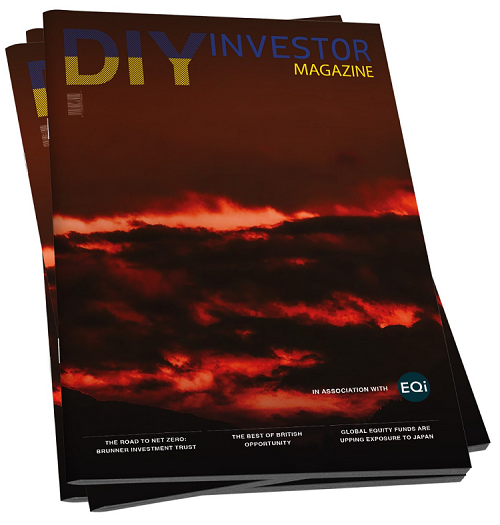Aug
2023
QD view – Divining higher income in an inflationary environment
DIY Investor
7 August 2023
 The outlook for the UK equity market looks particularly depressed: inflation is stubbornly high, surprising many commentators who expected to see it tumble as energy costs wane – by Matthew Read
The outlook for the UK equity market looks particularly depressed: inflation is stubbornly high, surprising many commentators who expected to see it tumble as energy costs wane – by Matthew Read
Higher inflation brings higher interest rates, which it seems, will persist as the UK’s central bank tries to cool the economy. Bank of England base rate is 5% – its highest for 15 years – with commentators expecting a peak as high as 6.5%, bringing higher mortgage rates, and greater government borrowing costs; it recently sold £4bn of October 2025 gilts, at 5.668% – the highest since the Debt Management Office was established in 1998.
Already weak, UK finances are deteriorating, as government debt rose above 100% of GDP in June – the first time since March 1961, and the highest in over 62 years – and there are plans to sell £241bn of gilts this year, up from £139bn in 2022; there is much for people and markets to worry about.
Persistent inflation – in part a pandemic hangover
One reason inflation has remained high relates to the pandemic, when some workers left the workforce permanently; this reduced the pool of available talent, sustained higher employment levels, and put upward pressure on wages. ONS says average weekly pay increased by 7.4% in the year to April 2023.
‘There is much for people and markets to worry about’
The finance and business services sector saw the highest growth at 8.3%, followed by construction at 6.2%, but some commentators think wage inflation may actually be higher and has not yet peaked. If so, an environment of higher interest rates may be with us for some time, something that investors in search of income, will have to adjust to.
Real-terms erosion of savings
Higher inflation can be both a blessing and a curse for the income focused investor. Meagre in the post-GFC period, yields on bonds and savings accounts have perked up significantly as inflation has risen. Some banks now offer 6% on deposits but, with inflation at 7.9% in the year June, savings are still being eroded in real terms.
Debt versus equity
Investors have sold down equities to buy bonds, which makes sense given the returns that they have achieved. Bond funds have held up better than UK equity funds in the short term (0.86% over six months vs. – 1.64% for equity).
 Over 12 months, returns are comparable : 3.65% for bonds vs. 3.12% for equity, but over three years, UK equity income has provided a median return of 6.99% p.a, around two-and-a-half points ahead of debt at 4.48%.
Over 12 months, returns are comparable : 3.65% for bonds vs. 3.12% for equity, but over three years, UK equity income has provided a median return of 6.99% p.a, around two-and-a-half points ahead of debt at 4.48%.
Despite its near-term performance, debt is not necessarily a long-term solution – over 10-years, UK equity income has given you an extra 1.13% per annum compound and, in an inflationary environment, equity tends to outperform.
Screening for yield and positive total returns
I have selected some higher yielding bond funds and UK equity income funds that have provided superior long-term total returns.
‘An environment of high interest rates may be with us for some time’
I considered funds that provide a yield in excess of 6% – currently achievable on bank deposits – and a total return in excess of 4.5% per annum, taken over 10 years to smooth out the effects of the pandemic and, the Brexit referendum, which still distort the five-year numbers.
Not many make the cut from UK Equity Income
Unsurprisingly, relatively few meet these stringent criteria – a higher bar for income limits capital growth prospects. From the sector, only one trust makes the list – Chelverton UK Dividend Trust. With a market cap of just £34m and a spread of 5.1%, it is not going to be suitable for many, although its yield of 8.0% allows it to trade at a 3.9% premium to NAV.
Debt – Loans and bonds – the chosen few
From Debt – loans and bonds, three funds make the cut: CQS New City High Yield (NCYF), CVC Income and Growth’s sterling shares (CVCG) and Invesco Bond Income Plus (BIPS).
NCYF has the highest yield at 10.0%, the highest on offer in the sector. Next highest is 8.9% from the soon to be defunct NB Global Monthly Income Fund (NBMI), although it’s yield is high for a reason – its returns are way behind the peer group (2.78% p.a. vs a median of 4.01%).
NCYF – cheap versus history, despite yield and long-term performance
NCYF delivered a NAV total return of 4.56% p.a.; a combination of high yield and outperformance means this fund tends to trade at a premium to NAV. Currently trading at a discount of 1.4% it looks cheap relative to history where it has had a five-year average premium of around 5%; I would not expect this to persist.
NCYF invests in predominantly higher-yielding fixed income securities targeting a high level of quarterly income, with some prospect for capital growth. Its veteran manager, Ian “Franco” Francis, aims to build a “sleep at night” portfolio for investors looking for a high level of income that don’t wish to take too much risk. This has played out in its recent NAV performance (NAV total return is -0.80% over six months), although not reflected in NCYF’s share price (share price total return is -13.97% over the same), hence the move to a discount.
In May last year, Ian said he felt interest rate rises maybe too little, too late, so he positioned the fund’s portfolio accordingly, edging up exposure to equities, which has been to NCYF’s advantage.
CVC Income and Growth – Also cheap despite yield and outlook
CVCG has experienced a purple patch; in its annual report to 31 December 2022, its chairman said current market conditions are inherently attractive for the company. Increased credit spreads, together with increasing risk-free rates on offer by central banks, have driven the yield on the underlying portfolio to levels not seen for many years.
‘CVCG has experienced a purple patch’
At the end of Feb 2023, the yield to maturity on the underlying portfolio was 17.3% (€ hedged) / 19.0% (£ hedged), with running cash yields of 11.5%/13.1%. Floating rate instruments comprised 83.2% of the portfolio and with prevailing economic conditions and inflation data suggesting a “higher for longer” expectation for risk free rates, this indicated continual favourable conditions for the fund, as its manager deploys capital to fresh positions at higher all-in rates. Currently, CVCG offers a yield of 7.7% (quarterly payments) and is available at a discount of 7.6%; like NCYF, cheap relative to its history.
Invesco Bond Income Plus – compelling long-term performance but expensive versus history
BIPS (previously City Merchants High Yield) invests in high-yielding fixed-interest securities targeting both high income and capital growth. Fund manager, Rhys Davis, is responsible for its long-term track record and BIPS is the largest fund in the Debt – loans and bonds sector. It currently offers a yield of 7.1% (with quarterly payments) and has returned 4.74% p.a. over the last 10 years (fractionally ahead of NCYF, arguably its closest competitor).
‘Even with the best headline rates, savers are still getting poorer in real terms’
BIPS NAV twelve month total performance of 4.09% has been more than compensated for with a share price total return of 6.80%; the trust has moved from a 6-7% discount to a 0.7% premium, making it the most expensive trust in a sector that trades at a median discount of 7.2%.
As the sole remaining fund in the UK equity and bond income sector, Henderson High Income (HHI) often gets undeservedly overlooked. With a yield of 6.35% and a 10-year NAV total return of 5.76% p.a., it clears our yield and return hurdles with ease. It’s also had a pretty decent 12 months with NAV and share price total returns of 4.62% and 6.64%, and has tended to trade in a range of around 2% above and below par during the last couple of years.
Henderson High Income – UK equities enhanced by an allocation to bonds
HHI differs from these higher yielding funds in that it predominantly invests in both well known and smaller UK listed equities, rather than bonds. However, a portion of its gearing (typically 22-24% of its net assets) is allocated to fixed income investments. This strategy enhances income returns, dampens overall volatility of the portfolio, and should achieve greater capital growth over time.
‘It may be time to think about additional income protection’
We would like to see HHI in the UK equity income sector, but in the meantime this peer group is the best against which to assess its characteristics and performance. With its higher income focus, HHI’s yield is, unsurprisingly, way above the peer group median of 4.75%, but its NAV total return is also ahead of the sector median of 3.12%, so higher income hasn’t come at the expense of total return – over 10 years, HHI’s NAV total return is 5.76% p.a. – 0.6% ahead of the sector median.
Its overweight allocation to equities was a key driver of its outperformance during 2022; we think that it can continue to benefit from the inherent inflation protection offered by equities.
The time is now
With inflation likely to persist, and further interest rate down the line. Banks have increased interest rates, but are being berated for profiteering and apparently not passing on all of the benefits – even with the best headline rates, savers are still getting poorer in real terms.
Closed-end funds, which don’t have to sit on under-earning cash to fund redemptions, are one place that investors can look to for solace. As the above discussion shows, it may not be possible to offset the full inflationary costs in the short term, but there are plenty of opportunities that offer a decent yield and the prospect of capital growth over the longer-term, which should go a long way to limiting its impact.
Matthew Read is a senior analyst at
Commentary » Investment trusts Commentary » Investment trusts Latest » Latest » Mutual funds Commentary

Leave a Reply
You must be logged in to post a comment.